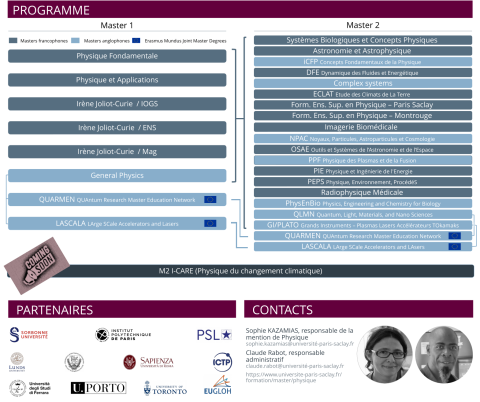Physics
The aim of the Master of Physics is to provide students with a high-level experimental and theoretical scientific training, based on the broad spectrum of physics research fields at Université Paris-Saclay and in relation to current issues in research and development.
The variety of pedagogical approaches (conceptual or application-oriented, offering the possibility of immersion in a laboratory or in a company, aiming at professional integration after 5 or 8 years of higher education) is adapted to various student profiles, and offers numerous possibilities of career opportunities.
The Master of Physics is open to all national and international students, French or English speaking. It offers several basic general physics programmes in the first year (in French: M1 Fundamental Physics, M1 Physics and Applications; in English: M1 General Physics) which allow students to choose their M2 specialization at the end of the M1 year. Another track (M1 MONABIPHOT, in English), focused on theoretical and experimental aspects of photonics at the interface with other fields, is also available.
An Erasmus mundus program (LASCALA) will open in September 2021. It is a two year master program shared by four partner universities (Lund, Szeged, Roma, Paris-Saclay) in the field of large scale accelerators and lasers which offers unique mobility and scholarship opportunities for master studies. In 2021 a new master program (QLMN) dedicated to Quantum Light Materials and Nanosciences will also open and benefit from the strong partnership between laboratories and private sector companies working in the field of the new quantum revolution.
In the second year, the Paris-Saclay Master's specialisation in Physics offers an exceptionally wide range of 20 programmes: conceptual and fundamental M2s prepare for doctoral studies and research in Academia and the public sector; more applied M2s prepare for the doctoral studies and research in the public and private sectors; M2s with a professional vocation open up to employment in the private sector and government agencies, without excluding PhD opportunities; some M2s specifically prepare for French national teaching competitive examinations. In addition, the "Irène Joliot-Curie" courses offer M1/M2 tracks to pupils and students of the Paris-Saclay Grandes Écoles (ENS Paris-Saclay and IOGS) and of the Magistère de Physique Fondamentale validating a complementary diploma in parallel with the Master's Degree in Physics.
Latest news for 2021/2023:
In the framework of the national French Quantum plan, that was announced officially by President Macron at C2N in Université Paris-Saclay on the 21 January 2021, the former Master programmes LOM and Nanosciences join to propose a common Master programme from September 2021: QLMN (Quantum, Light, Materials and Nanosciences). This programme will benefit from the strong partnerships between our local academic laboratories and the numerous companies working in the field of quantum technologies in Paris-Saclay.
Two Erasmus Mundus programs are open: one dedicated to large scale accelerators and lasers (LASCALA) and one to quantum physics and technology (QUARMEN) . They are supported by the European Commission and offer a large number of mobility master scholarships. The applications must be done directly on the websites: https://master-lascala.eu/ or https://master-quarmen.eu/
Depending on the M1 study programmes, students tend to come from either undergraduate studies at the Ecole Universitaire de 1er cycle Paris-Saclay, or Joint Honours undergraduate courses of Université Paris-Saclay, or from the L3 Dual Qualifications + Diplomas of ENS Paris-Saclay, Institut d'Optique Graduate School and Magistère de Physique d'Orsay. All students coming from a Paris-Saclay L3, other L3 in France or from an equivalent level abroad are given the opportunity to prove themselves during the M1 year, without any a priori restrictions on the M2 disciplines they can access. This mode of organisation opens transfer paths between all study paths at the end of the M1 year. Any student admitted to an M1 will have the possibility of going on to Master's studies in a Physics M2.
Sorbonne Université
Université de Paris
Université Paris Sciences et Lettres
Institut Polytechnique de Paris
Lunds Universitet (Sweden) - Szegedi Tudományegyetem (Hungary) - Università degli Studi di Roma "La Sapienza" (Italy) - University of Toronto (Canada) - Universidade do Porto (Portugal)
Politecnico di Torino, Scuola Internazionale Superiore di Studi Avanzati, Abdus Salam International Centre for Theoretical Physics (Italy)
Università degli Studi di Ferrara (Italy)

Schéma Master
Master and use the specialized knowledge of physics with the required scientific rigor.
Become informed and carry out research on a scientific issue by knowing how to identify relevant sources of information
Use conceptual, methodological, numerical, technical and practical skills for modelling and solving problems in physics or related subjects.
Conceptualize, structure and independently conduct a project in physics and produce a critical analysis of the results.
Adapt to a new environment, work as a team and collaborate to achieve common goals
Summarise and communicate effectively in two languages including English and in a manner which is suitable for the target audience
